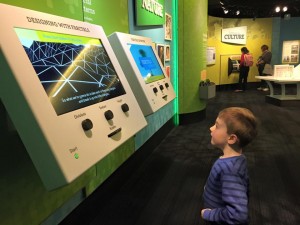Museums fight for funding
Jack McCarthy — May 3, 2015
A young boy learns about fractals at Chicago’s Museum of Science and Industry, a popular museum destination for families throughout Illinois.
Illinois museums aren’t dusty relics of forgotten times.
The state’s 1,300 institutions are a vibrant economic engine that employ thousands and attracts millions of visitors who spend up to $1.6 billion annually.
“It’s very easy to make the case for broad support for museums,” said Bonnie Styles, Illinois State Museum director. “They provide unique core educational experiences and resources for everyone from pre-schoolers to senior citizens.”
But Illinois Association of Museums members who gathered at the 17th Illinois Museum Day in Springfield April 23 still felt compelled to remind state legislators and executives about the cultural and financial impact of their institutions.
IAM officials also hoped to reinstate $20 million in frozen grant funds while heading off potential draconian budget cuts as wrangling over solutions to short and long-term budget deficits continued.
According to an IAM economic impact report issued last month, the state’s museums, historic sites, zoos, science centers and other attractions drew more than 19 million visitors in 2014 — more than the combined attendance of Chicago’s professional sports teams.
Visitors to Illinois museums added more than $1.6 billion to the state’s economy while those institutions spent more than $480 million in goods and services, employed more than 5,600 people and attracted more than 15,000 volunteers.
Moreover, IAM said museums reached more than 2.9 million schoolchildren, including school visits to institutions, school outreach, traveling exhibits and other programs. More than 210,000 teachers also benefited from professional development programs and other support.
“(Museums) attract residents and tourists to our communities,” said Styles. “They bring in federal grants and dollars from many different sources, they spend a lot of money in their communities, they create jobs and entice businesses to reside in Illinois.
“Illinois without its museums would be a culturally sterile place where I certainly wouldn’t want to live and I don’t think anybody would want to develop a business here,” she added.
Nationally, the American Alliance of Museums estimated there are approximately 850 million museum visits yearly with an economic impact of $21 billion.
The Alliance also reported that every $1 invested in museums and cultural attractions returned $7 in tax revenues.
IAM president Kate N. Schureman said strengthening lines of communication was a crucial component of last week’s meetings.
“When you find out that a bill has been introduced and it eliminates a form of funding or it’s consolidation of departments or it cuts out museums from being able to provide teacher professional development, we all look at each other and wonder how did this happen?” she said.
Schureman, vice-president/administration and COO of the Peoria Riverfront Museum, also told IAM members that their efforts were a long-term process.
“Advocacy is a marathon, it’s not a sprint,” she said. “You have to keep coming back and building those relationships with your elected officials. … Advocacy is also about the power of your story, the power of one and the power of education because you are going to helping educate your elected officials.”
One immediate piece of business is unfreezing capital spending grants not just for the current year but — as in the case of one Rockford museum — funding dating back to 2012.
IAM said a $50 million Public Museum Capital Grants Program was approved in 2009 and grants were issued in 2010 and 2014. But an estimated $20 million in grants awarded in June 2014 were suspended last month, even as many projects had already begun.
Gov. Bruce Rauner imposed the grant freeze and other spending limits as the state grapples with deficits in both current and next year’s budgets.
A Republican and conservative business executive elected last November, Rauner employs a budgeting approach that reflects that background. He’s proposed a series of budget cuts and consolidations, including one that immediately affects the museum and historic preservation communities.
Julia Bachrach, Illinois Historic Preservation Agency board of trustees member, warned IAM members that her 30-year-old agency was in danger of being dismantled.
“We are a small agency with a very important job — to preserve, protect and interpret history of the state of Illinois,” she said. “We are more than just tourism, we ensure that our state’s treasures — from artifacts to buildings — are preserved with the highest integrity and expertise and we educate our children, Illinois citizens and the nation about our history.”
Bachrach said proposed legislation would merge part of the IHPA into the state’s Department of Commerce and Economic Opportunity, an agency that lacks expertise and that Rauner seeks to privatize.
Larry Suffredin, legal counsel and lobbyist for Museums in the Park, an umbrella organization of 11 Chicago museums, said Rauner’s approach is a sea change.
“We have a person who is governor who has a different vision of how the government should work,” Suffredin said. “It doesn’t mean it’s a bad vision, it’s just a different vision. He’s trained as an MBA, which means he looks at metrics and different ways of approaching things. He looks at the separation of powers differently.
“What is in our control is the ability to go and educate people here,” he said. “We’re not here to pick battles, we’re here to solve problems.”







